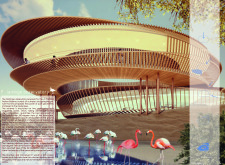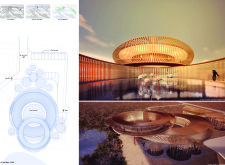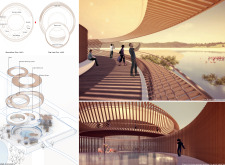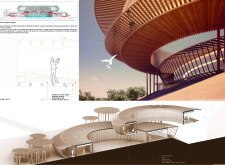5 key facts about this project
The design comprises two intersecting circular forms that create a unique spatial organization. These forms are arranged to optimize panoramic views of the landscape, enhancing the visitor experience. Elevated observation decks allow unobstructed sightlines of the wildlife, while strategically placed amenities, including a café and information areas, support visitors' needs. The internal courtyard, featuring a reflective water body, not only serves as a gathering space but also embodies the project’s commitment to promoting biodiversity.
Innovative Use of Geometry and Materials
A key feature of the Flamingo Observatory is its distinct geometric layout, which diverges from conventional architectural forms typically employed in similar facilities. The spiraled arrangement of the building encourages exploration and movement, guiding visitors through carefully curated pathways that lead to various observational points. This thoughtful configuration aligns with the overall aim of enhancing the visitor experience while respecting the ecological context.
The material selection is another significant aspect of the design. Sustainable timber is utilized for the structural framework, contributing to both aesthetic warmth and compatibility with the natural environment. Large glass facades facilitate interaction with the exterior, allowing natural light to permeate the interior spaces while providing unobstructed views of the surrounding reserve. A wooden screening system reinforces the connection between the building and its environment, offering shade and reducing energy consumption by optimizing natural ventilation.
Functional Integration and Environmental Considerations
Functionality is central to the observatory's design. Each area within the structure is purposefully crafted to support various activities, from birdwatching to educational workshops. The observation areas are supplemented with interpretative signage that informs visitors about the local ecology and conservation efforts.
Environmental considerations play a critical role in the building’s operations. The design employs passive strategies for thermal comfort, utilizing the building's geometry to enhance airflow and reduce reliance on mechanical systems. The incorporation of water features not only augments the aesthetic but also acts as a micro-ecosystem, supporting various forms of wildlife.
To explore the architectural plans, sections, and designs of the Flamingo Observatory in greater detail, consider reviewing the project presentation. Detailed insights into the architectural ideas behind the observatory will offer a deeper understanding of its innovative approach to blending architecture with the natural environment.


























